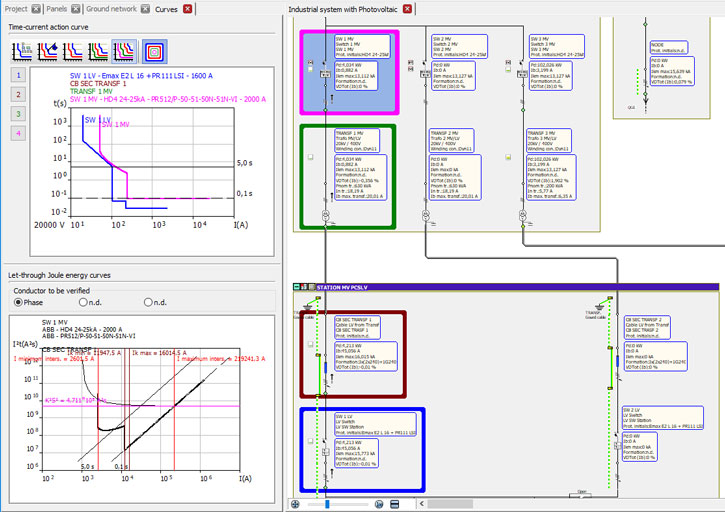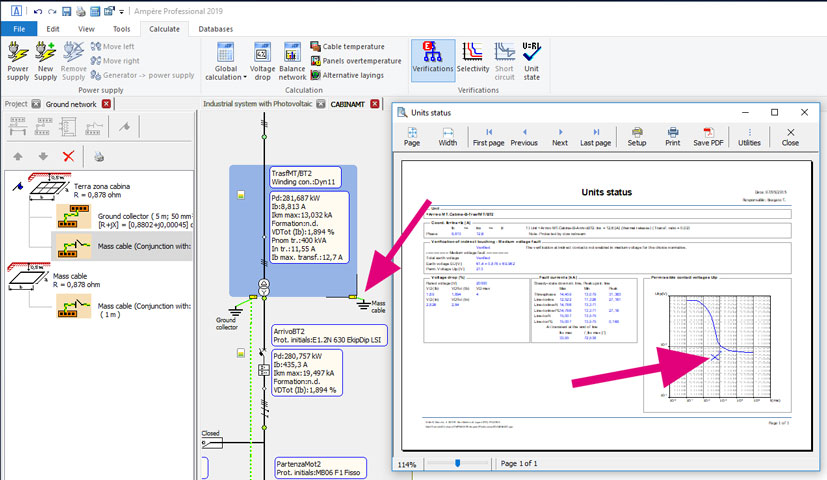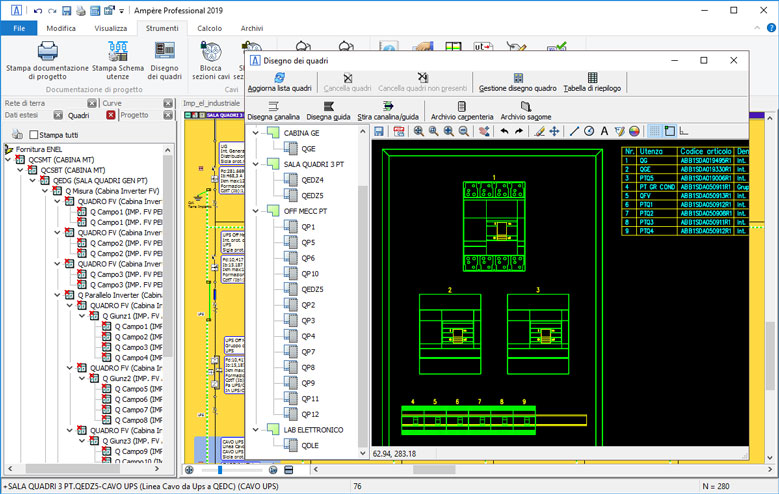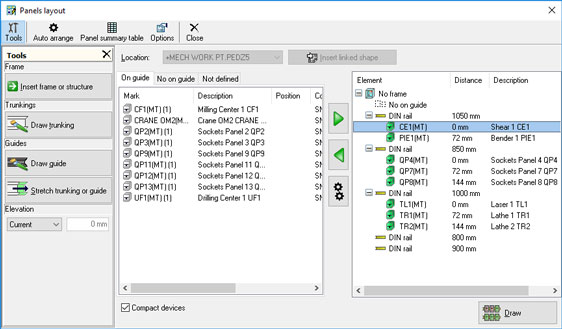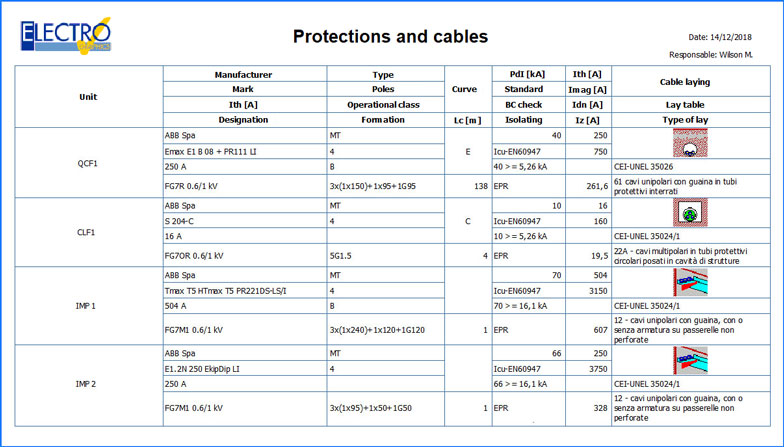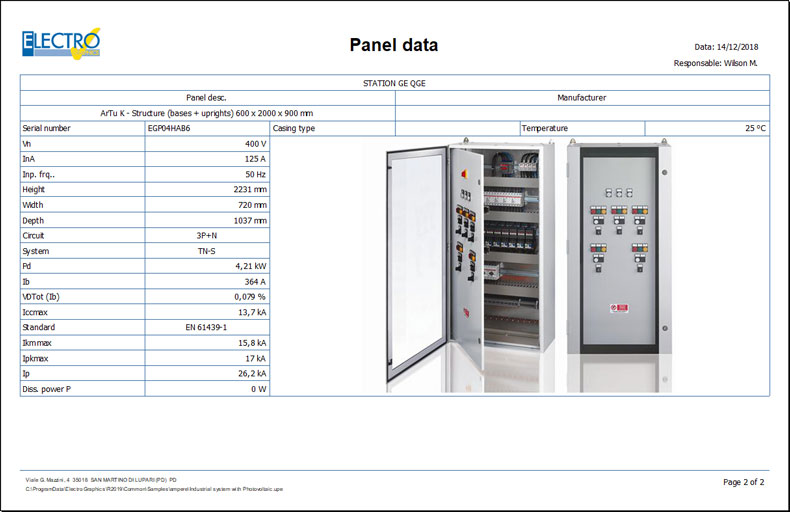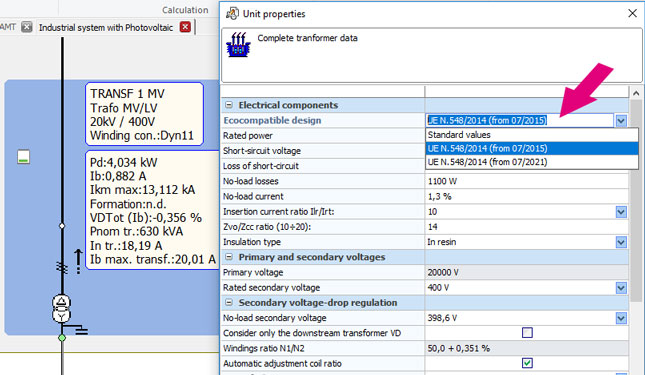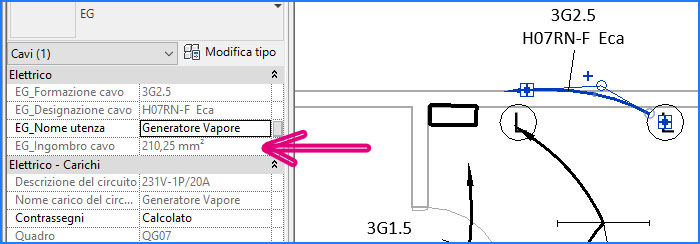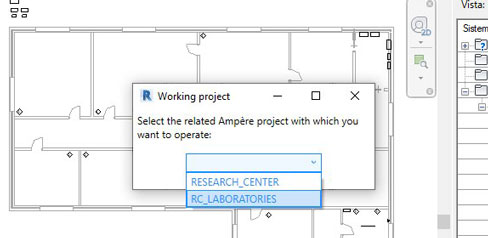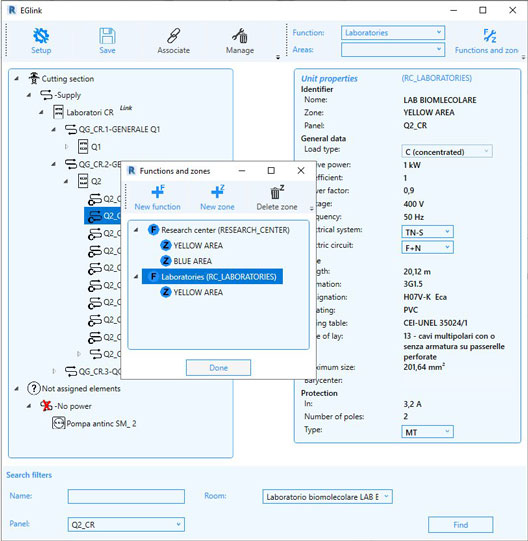New features 2019 Series - Electrical grid calculation
Electro Graphics releases the latest 2019 Series of electrical and photovoltaic design software. Here are the most important features and enhancements introduced about Electrical grid calculation in the software Ampère line and EGlink.
See all new features 2019:
Update to the new edition of IEC 60909-0:2016 regarding the calculation of fault currents on electrical networks
Ampère 2019 incorporates the new edition of the standard for the calculation of short-circuit currents in AC three-phase systems. The main changes introduced at the calculation level concern the adjustment of some calculation factors.
- Voltage factor c for LV networks.
- Factor for correcting the direct, inverse and homopolar impedance for the calculation of the maximum shortcircuit currents for two-winding transformers (IEC 60909-0 para 6.3.3) and generators (IEC 60909-0 section 6.6.1).
- Factor for correcting the impedance for the calculation of initial maximum currents in systems supplied directly from generators without intermediate transformers (IEC 60909-0 para 6.3.3) and generators (IEC 60909-0 para 6.6.1).
- Factor for correcting the overall high impedance of the transformer to calculate the initial maximum shortcircuit currents in the production groups WITH automatic voltage regulation of the transformer (IEC 60909-0 section 6.7.1).
- Factor for correcting the overall high impedance of the transformer to calculate the initial maximum shortcircuit currents in the production groups WITHOUT automatic regulation of the transformer voltage (IEC 60909-0 section 6.7.2).
Management of the new triangular and rectangular capability curves for the inverters
Ampère 2019 enhances the definition of capability curves, also called Performance curves, and integrates new types of curves for inverters.
• Inverter in systems with P <= 11.08 kW (triangular);
• Bidirectional inverter (rectangular);
• Bidirectional inverter (triangular).
New interface for the verification of selectivity between multi-level protections with in-line update of the selectivity curve according to the modified settings
All the controls for adjusting the protection settings are now also available in the useful Advanced Curves panel, always open at the side of the mesh. This avoids the need to call up the Selectivity window for each protection and maintain full visibility on the electrical network, highlighting the protections in question. The new Curves panel shows the preview of the intervention curves for the selected utilities and the direct access to the settings in the Calibration window.
Calculation of the total earth voltage UE on the primary of MV transformers in fault conditions
For transformers with primary side in MT it is now possible to define also the cabin mass earth collector, ie the connection of the carcass to the ground; this new feature allows to refine the calculation of the total earth voltage UE and verify the fault with respect to the UTP contact voltage.
The total earth voltage UE of an electrical system with respect to a sink is the voltage value that is established in case of phase-ground contact between the earthquake itself and the points of the ground sufficiently distant to be considered potential-free.
For the verification of the primary side fault of a medium voltage transformer, Ampère calculates the values of the total earth voltage in the user in question given by all the earth fault current that passes on the user's sink, as in the case of cabins powered by overhead lines without a grounded guard line.
The new Unit status window in Ampère 2019 displays the contact voltage provided by the IEC 61936-1 standard, ie the curve that indicates the voltage limit that an average person can withstand over time, and facilitates the graphic check of the total voltage UE ground in transformers: if it is lower than the UTP contact voltage, then the system is also protected for step voltages.
New EGCAD manager, to draw the panel carpentries, with the placement of devices (boxed or modular), without the need for external CAD resources, and save on .dwg file
The new instrument allows the representation of the panel layout fronts referring to the electrical grid panel calculated in Ampère. All operations take place in an interface within Ampère where a multi-sheet diagram and the tools of a dedicated CAD environment are available.
The built multi-sheet is standard Electro Graphics type, and it can be elaborated in CADelet, Eplus, iDEA; you can choose the configuration set that determines the sheet title block and squaring block.
The drawing window presents the list of the panels defined in the Ampère project's electricity grid, divided by area: each one panel refers to one sheet in which to draw the panel carpentry and other elements.
All the necessary tools for the drawing of the panel are available: with the choice in the Carpentry archive of the structure or frame of the cabinet or cabinet, the block of the frame and of the other elements that make up the wardrobe or cabinet is proposed (door, panels, accessories,...) according to the pre-established compatibility in the database. Also for the drawing of guides and the trunkings, simply select the model from the databse and quickly place the pieces on the carpentry.
A summary table of the inserted devices can finally be attached to the layout drawing.
The created schema is saved in an AutoCAD® drawing file (DWG format) and can be published in PDF format.
New tool for printing technical attachments, with customizable templates
The tool for the composition of the printouts of technical documents has been deeply updated and improved introducing the possibility to customize the printing models or to create new ones.
The customization of the models is probably the most interesting news, as well as the possibility to print multiple documents queued, to improve the selection of units to be included in prints with multiple filters by Zone and Panel. The setup of preferences is now simplified and configurations are automaticaly saved for each type of document.
Template customization is a powerful tool for quickly creating printouts with the information and graphic features you need. For the creation or modification of an Ampère document template, you can use any spreadsheet editor that saves files in .XLS format (Excel file version 97-2003). The spreadsheet, widely known as a working tool, allows a total customization of the prints.
The arrangement of labels in the cells will result in a totally customizable print layout.
Environmentally friendly transformers, according to EU regulation n.548/2014
The EU Regulation N.548 / 2014 establishes the (mandatory) requirements for eco-design for electrical transformers with a minimum power of 1 kVA used in electricity transmission and distribution networks. It indicates the maximum load and empty losses that must be respected by the various types of transformers.
The regulation provides constructive constraints for builders allowing a progressive path, with two steps depending on the time (July 2015 and July 2021) with decreasing dissipated power values.
The choice of transformers can now be guided by Ampère just defining which family the transformer belongs to. In addition to the 'standard' type, others transformers can now be configured to meet the new eco-compatible requirements according to EU Regulation N.548/2014. In the machine data it is now possible to specify the nominal power and dissipated power values according to EU N.548/2014 with specification 07/2015 and 07/2021.
Management of units with single-pole device combinations for the protection of single-phase lines, realized with the sharing of three-phase and PE common conduit
You can now assign 1P unipolar devices to 3F+N or 2F+N units, and manage multiphase systems with neutral pole with independent device.
During the selection of protection, Ampère accepts a unipolar protection and automatically assigns one item to each phase. The neutral is not protected, while the correct counting of the devices is carried out for printing and data exports.
Increase of calculation speed in network processing, with improvements of up to 200% in the calculation of faults
It is now possible to set the Ampère calculation mode to take advantage of the increased CPU speed when available. With the new Multi Thread option the calculation program exploits the processors by making them work in parallel, increasing the calculation performance.
In particular, optimization takes place in the calculation of short-circuit failures, faults in indirect contacts, voltage drops.
The 2019 version sees increased speed also for access to the database, from which it derives a further increase in the speed of use of Ampère in the modification of data, the calculation and verification of the electricity grid. The increase in speed can be noticed particularly by using the shared files on the network with access from multiple locations.
The value of Delta Ib can be set for each individual unit
The Delta Ib value, percentage increase in the operating current for the nominal current calculation, can now be set for each unit. In the Properties window, on the Rules and global constants tab, you must enable the For each user option, positioned after the Global percentage increase value. In the unit data editing window, you will find the Electrical details tab, in which you can set the desired value.
New graphics signals according to the voltage drop and the overload currents with respect to Iz or In
The connection points between units now are green, olive, yellow, orange or red, depending on the voltage drop Cdt Ib Total.
To the left of the distribution type units, an icon represents bands of green, olive, yellow, orange, red, the overload with respect to the cable Iz or to the protection In, considering the heaviest of the two.
These signals can be enabled or disables on the Display options in the Ampère Properties window.
Extension and updating of the device database
New series for all types of devices have been added to the Ampère database.
EGlink is an interchange plug-in between Autodesk Revit and Ampère Professional and represents the Electro Graphics's response to BIM (Building Information Modeling) process mode. Following the main new features in the 2019 version of EGlink.
Compatibility with Revit 2019
EGlink 2019 is now compatible with Revit MEP 2016/2017, Revit 2018 and Revit 2019.
Compact representation of cable units with the possibility of distinguishing between concentrated, barycentric and distributed loads
EGlink 2019 allows you to choose between two possible ways of representing electrical power circuits: compact and extended. This option determines the way in which the electrical power circuits detected in the Revit project are interpreted and represented in the Revit user tree first and in the related Ampère files then.
In the extended representation mode each terminal element (load) detected is represented as a single user, ie there is always a one-to-one correspondence between the single Revit element and the related Ampère user; this mode is suitable for detailed but not very extensive electricity networks.
For projects of considerable size, with a particularly extensive mesh, it is useful to apply a compact representation mode, in which for circuits with terminal loads connected downstream it is possible to choose between the following options:
• Circuit with concentrated load
• Circuit with distributed load
• Circuit with barycentric load
The representation of the distribution circuits, in both modes, can be of the normal type or upright.
Estimated cable size starting from Ampère data and saving in Revit model
EGlink 2019 provides an estimate of cable size starting from Ampere user data related to the Revit type of circuit type. This data can be displayed directly in the Revit model in the parameters related to the project cables (user name, training, designation and cable size).
It is also possible to create customized labels and display the estimate of the hollow space in the project annotations.
Definition of functions and functional areas for the division of Revit model elements into multiple work files
In projects of considerable size, it may be necessary to distinguish several functional zones within the Ampère file itself and to organize the Revit model users in several project files.
As a solution to this requirement, EGlink 2019 introduces the concept of function and functional zone. The function represents the aggregation criterion of a certain number of electrical elements that will be processed and dimensioned within the same Ampère project file.
Within the same project file, the designer can also define multiple functional zones.
The definition of functions and zones allows the operator to filter the elements of the Revit project by function and functional area.
Management of Ampère multi-project files related to the Revit project
EGlink 2019 allows you to manage multiple Ampère project files related to the same Revit project by defining multiple functions, one for each related Ampère file.
After selecting the Ampère project, you can take advantage of all the EGlink features to edit, update, rework the related projects and maintain bidirectional synchronization between the Revit project and all associated Ampère project files. The Functions drop-down list on the toolbar allows you to quickly switch from one project file to another.
Introduced search filters in the Revit user tree by name, panel and zone
To simplify the work in the EGlink interface, there are now useful filters for name, panel and room that allow users to quickly find the units.
See all new features 2019:





